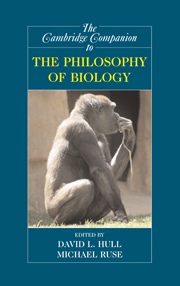Book contents
- Frontmatter
- 1 Adaptation
- 2 Population Genetics
- 3 Units and Levels of Selection
- 4 What’s Wrong with the Emergentist Statistical Interpretation of Natural Selection and Random Drift?
- 5 Gene
- 6 Information in Biology
- 7 Reductionism (and Antireductionism) in Biology
- 8 Mechanisms and Models
- 9 Teleology
- 10 Macroevolution, Minimalism, and the Radiation of the Animals
- 11 Philosophy and Phylogenetics: Historical and Current Connections
- 12 Human Evolution: The Three Grand Challenges of Human Biology
- 13 Varieties of Evolutionary Psychology
- 14 Neurobiology
- 15 Biological Explanations of Human Sexuality: The Genetic Basis of Sexual Orientation
- 16 Game Theory in Evolutionary Biology
- 17 What Is an ‘Embryo’ and How Do We Know?
- 18 Evolutionary Developmental Biology
- 19 Molecular and Systems Biology and Bioethics
- 20 Ecology
- 21 From Ecological Diversity to Biodiversity
- 22 Biology and Religion
- 23 The Moral Grammar of Narratives in History of Biology: The Case of Haeckel and Nazi Biology
- Reference List
- Index
- Series List
21 - From Ecological Diversity to Biodiversity
Published online by Cambridge University Press: 28 April 2008
- Frontmatter
- 1 Adaptation
- 2 Population Genetics
- 3 Units and Levels of Selection
- 4 What’s Wrong with the Emergentist Statistical Interpretation of Natural Selection and Random Drift?
- 5 Gene
- 6 Information in Biology
- 7 Reductionism (and Antireductionism) in Biology
- 8 Mechanisms and Models
- 9 Teleology
- 10 Macroevolution, Minimalism, and the Radiation of the Animals
- 11 Philosophy and Phylogenetics: Historical and Current Connections
- 12 Human Evolution: The Three Grand Challenges of Human Biology
- 13 Varieties of Evolutionary Psychology
- 14 Neurobiology
- 15 Biological Explanations of Human Sexuality: The Genetic Basis of Sexual Orientation
- 16 Game Theory in Evolutionary Biology
- 17 What Is an ‘Embryo’ and How Do We Know?
- 18 Evolutionary Developmental Biology
- 19 Molecular and Systems Biology and Bioethics
- 20 Ecology
- 21 From Ecological Diversity to Biodiversity
- 22 Biology and Religion
- 23 The Moral Grammar of Narratives in History of Biology: The Case of Haeckel and Nazi Biology
- Reference List
- Index
- Series List
Summary
INTRODUCTION
During the last three decades, biodiversity conservation has emerged as a central focus of environmental concern in many regions of the world (Sarkar 2005). As a result, large-scale efforts are being devoted to devising systematic protocols for conservation, sometimes involving computational efforts unprecedented in ecology (Margules and Pressey 2000). These efforts presume that a sufficiently precise concept of biodiversity is at hand. Some philosophical attention has also been focused on elaborating an adequate normative basis for conservation. These attempted normative justifications for biodiversity conservation also depend on what is meant by biodiversity. Yet, “biodiversity” remains a contested term.
The term “biodiversity” was first used in 1986 as a contraction for “biological diversity” by Walter G. Rosen while planning for a (U.S.) National Forum on Biodiversity (Takacs 1996). Subsequently, temporarily mutated as “BioDiversity,” it was used as the title for the proceedings from that meeting (Wilson 1988). No attempt was made to define the term precisely, even as its use spread - the chronology in Table 21.1 includes the most salient episodes. Conservation biology also emerged as a distinct interdisciplinary research area during the 1980s with its central aim the protection of biodiversity (Takacs 1996, Sarkar 2002, 2005).
- Type
- Chapter
- Information
- The Cambridge Companion to the Philosophy of Biology , pp. 388 - 409Publisher: Cambridge University PressPrint publication year: 2007
- 7
- Cited by

